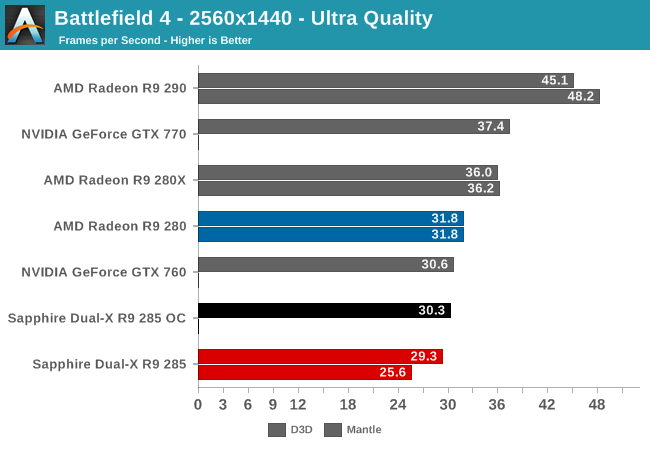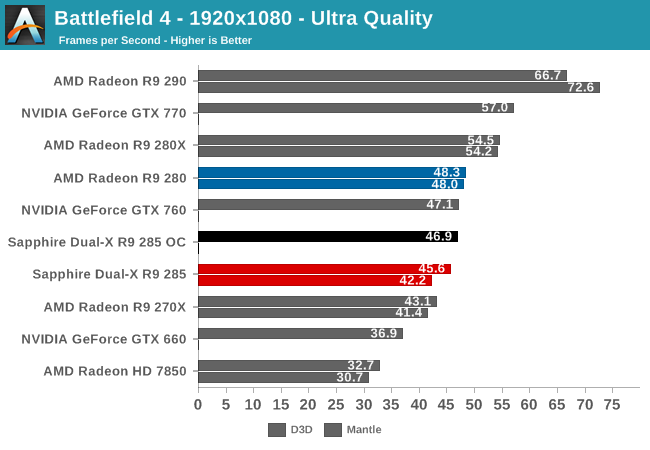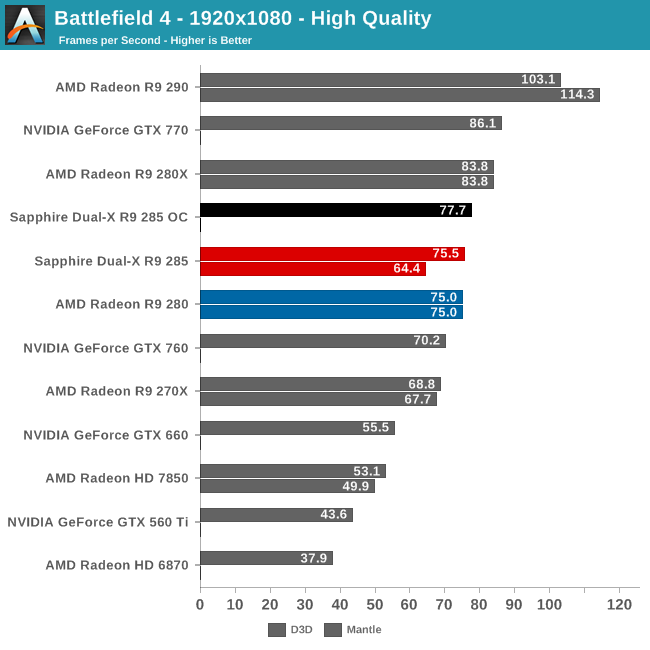AMD Radeon R9 285 Review: Feat. Sapphire R9 285 Dual-X OC
by Ryan Smith on September 10, 2014 2:00 PM ESTBattlefield 4
Our latest addition to our benchmark suite and our current major multiplayer action game of our benchmark suite is Battlefield 4, DICE’s 2013 multiplayer military shooter. After a rocky start, Battlefield 4 has finally reached a point where it’s stable enough for benchmark use, giving us the ability to profile one of the most popular and strenuous shooters out there. As these benchmarks are from single player mode, based on our experiences our rule of thumb here is that multiplayer framerates will dip to half our single player framerates, which means a card needs to be able to average at least 60fps if it’s to be able to hold up in multiplayer.



Our first Mantle-enabled game, Battlefield 4 shows the current Mantle R9 285 performance regressions front and center. At every resolution the R9 285 loses performance, sometimes remarkably so. As a result it is limited to Direct3D.
Regressions aside, I feel like Battlefield 4 is a good case for why the R9 285 needs more VRAM, or at the very least it’s not a good choice for 2560x1440. The sustained performance at 2560 is too low for this game, and the performance loss compared to the 3GB R9 280 appears to be a direct result of VRAM pressure. If the R9 285 had more VRAM, I suspect it would reach parity with the R9 280, especially given what happens at 1080p with High settings.
In any case, this is also the first game where the R9 285 trades blows with the GTX 760 rather than taking a distinct lead. With both cards limited to Direct3D, both cards are also returning similar performance. Which for R9 285 and its higher price tag is essentially a loss.










86 Comments
View All Comments
MrSpadge - Thursday, September 11, 2014 - link
The point is that Tonga is NOT a rebrand. It's a brand-new chip, AMD themselves call it the 3rd generation of GCN. Making a new chip costs AMD a sgnificant amount of money, that's why they haven't bothered yet to update Pitcairn to at least 2nd gen GCN (1.1). And I'm totally fine with that. It's also OK for nVidia to use GK104 for GTX760. What's not OK - from my point of view - is AMD investing into this new chip Tonga and hardly getting any real world benefit over the 3 year old Tahiti designs. If nVidia introduces a Maxwell which performs and costs them just the same as the previous Kepler, I'll call them out for this as well. But this is pretty much excluded, from what we've seen so far."And I highly doubt the 285 is 'all amd has'."
It's their 3rd gen GCN architecture, as they say themselves. There's going to be a bigger chip using this architecture, but apart from that I doubt we'll see anything from AMD in the next year which is not yet in Tonga.
just4U - Friday, September 12, 2014 - link
The one nice thing about the 285 is it will have resale value that has been lost on the 280-290 series thanks in large part to bit mining. There's a good chance that most won't feel that the 285 (and future incarnations) were run into the ground like the earlier ones were.Frenetic Pony - Wednesday, September 10, 2014 - link
Nah, what's interesting is that Maxwell may not be worth "responding" too. It's an almost totally mobile focused design, one that's not even totally out yet. If these benchmarks hold true then it's very exciting for AMD's upcoming high end. Nvidia may end up with a 512bit bus as well, but AMD's bandwidth optimizations will mean a similarly specced card of their's will still handily beat anything NVIDIA has in terms of resolution scaling.Heck it may even be enough to get a single GPU capable of running games at 4k at a reasonable fps. And that would be awesome. Maxwell might be good for Nvidia's mobile business, but I doubt it's going to help them take back the top spot for high end stuff from AMD.
mindbomb - Wednesday, September 10, 2014 - link
UVD always supported vc-1. The first version supported full decode of h264 and vc-1. You are thinking of nvidia, who didn't have full hardware decode on a real desktop part until fermi.mindbomb - Wednesday, September 10, 2014 - link
Not that it matters really. It stopped being relevant when hd-dvd lost to bluray.Navvie - Thursday, September 11, 2014 - link
A lot of blu-rays have vc-1 content.nathanddrews - Thursday, September 11, 2014 - link
Blu-ray.com has a database that you can search by codec. VC-1 is very much alive and thriving.Ryan Smith - Wednesday, September 10, 2014 - link
According to my DXVA logs, the 280 did not support VC-1/WMV9. That is what I'm basing that on.mindbomb - Wednesday, September 10, 2014 - link
I think your logs are referring to the nvidia gtx 280, which did not support full vc-1 decode. AMD had it since the radeon 2600xt, which is ancient.NikosD - Saturday, September 13, 2014 - link
True.One of the main advantages of first generation UVD (ATI Radeon HD2000 series) over Nvidia, was the full DXVA VLD support of both 1080p H.264 L4.1 (BluRay spec) and VC-1.